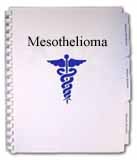|
Mesothelioma and Lung Cancer News - Return to Menu
SV40 not implicated in mesothelioma
6-Apr-2005 - New highly sensitive approach shows no evidence of SV40 in tumors – SV40 unlikely to be factor in asbestos related cancers SV40 does not have a role in the majority of malignant mesotheliomas -- a cancer associated with exposure to asbestos – according to a study in this month's Cancer Research. The study, led by Mount Sinai School of Medicine researchers used a scrupulous protocol that eliminated contamination that has likely been the reason previous studies have implicated SV40 in this cancer.
"Ever since the connection between asbestos and mesothelioma was first identified there has been intense focus on finding a secondary cause that would explain why some individuals contract the disease while others who have equal exposure to asbestos do not," said James Manfredi, PhD, Associate Professor of Oncological Sciences at Mount Sinai School of Medicine.
The possibility that SV40 might be this secondary cause came to light when it was discovered that polio vaccines widely used in the 1960's were contaminated with the virus. Recently, many studies have found low levels of SV40 in mesothelioma tumors.
Because SV40 must be present in every cell in order to block the functions of critical tumor suppressor proteins, Dr. Manfredi and colleagues argue that the low levels identified in tumors in earlier studies are insufficient to consider SV40 a cause of the cancers. Rather they explain that the SV40 found in these cells was likely the result of contamination.
"SV40 has been a widely used research model," explains Stuart Aaronson, MD, Professor and Chair of Oncological Sciences at Mount Sinai and co-author of the paper. "Since many DNA vectors used everyday in laboratories all over the world contain a portion of the SV40 genome it must be assumed that any sensitive test for SV40 might find this portion of the SV40 genome if rigorous methods aren't used to exclude contamination."
In the current study, the researchers designed a scrupulous protocol with the specific intent of eliminating any possible contamination. They then used a highly sensitive assay, capable of detecting the virus even if it were only present in one out of 5,000 cells. None of the 69 tumors they tested contained detectable levels of SV40.
Contact: Mount Sinai Press Office
newsmedia@mssm.edu
212-241-9200
Mount Sinai Hospital / Mount Sinai School of Medicine
Looking for Lung Cancer
By Michelle Aguayo
Aug 15, 2005 - The American Cancer Society says lung cancer is the leading cause of cancer deaths in men and women.
Its 2005 statistics estimate more than 160,000 people will die from the diseased this year.
But the fight against lung cancer is more than just numbers.
There are the faces and names of your friends, neighbors and family members.
You get a rare chance to go into the operating at Genesis Medical Center room to see a lung biopsy.
Medical Breakthrough looks at the fight against lung cancer through the eyes of a Quad City doctor -- on the front lines of diagnosis.
"There's a very nice picture of the lungs -- oh, that's sharp, that's nice."
Dr. Richard Sadler uses new digital equipment to help him find lung tumors. This is a surgery he performs more often than he'd like. Just today, he'll look for cancer in two patients.
"The black stuff we call carbonaceous material and that's from previous smoking," he says as a camera probes the lung of a female patient. The camera sends a digital image to two monitors Dr. Sadler can see as he scans the lung.
He's getting an up-close look at the lung. But before a patient ends up on his operating table, they've had a CT or CAT scan. The scan will show bright white spots which indicate there's a mass in the lung.
"The CAT scan is probably the single best test to look at the lung to see if you have lung tumors or lung infection or an anomoly that would explain our problem," he says.
Dr. Sadler can tell when his instrument glides over a lump -- one that's not supposed to be there. He can also see potential problems.
"Looks like a black crater -- that's probably a nodule we need to deal with," he says.
In a matter of minutes, he has the nodule in his clamp, a stapler clips it off and seals the lung. There is relatively little blood, or damage to the lung. Then Dr. Sadler pulls out the problem area and inspects it.
"What we're doing is cutting open the nodule or what I think is the nodule to convince myself I'm sending something down to the pathologist that will be of use."
In a matter of minutes, Dr. Sadler gets an answer.
In this case it isn't cancer, rather an infection that's caused nodules to form in the lung.
Good news for this patient -- but that doesn't keep Dr. Sadler from his conviction that we can make a difference in the diagnosis and treatment of lung cancer.
"We lose 160-to-170-thousand Americans to lung cancer a year. Most of which could be curable if we got to them early and even if they weren't curable, we could extend their lives."
Dr. Sadler says early screening, especially for people who smoke, would help find lung cancer earlier. He recommends smokers or former smokers regularly get a CT or CAT scan. Insurance won't pay the $300 or so cost, but Dr. Sadler says early detection can mean the difference between life and death and is worth the cost. He sites a Wall Street Journal article that also says it's a test worth the money.
He also hopes current studies will back him.
|

































